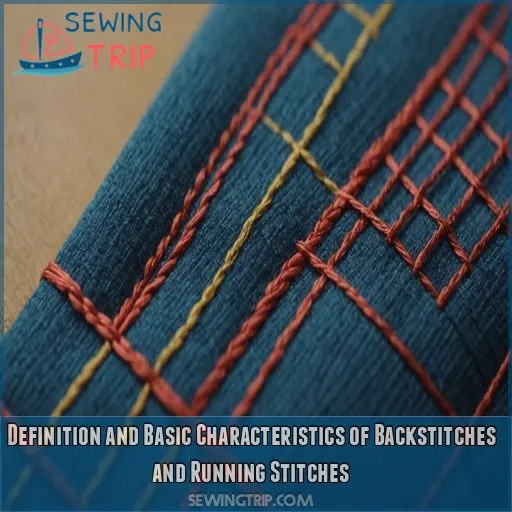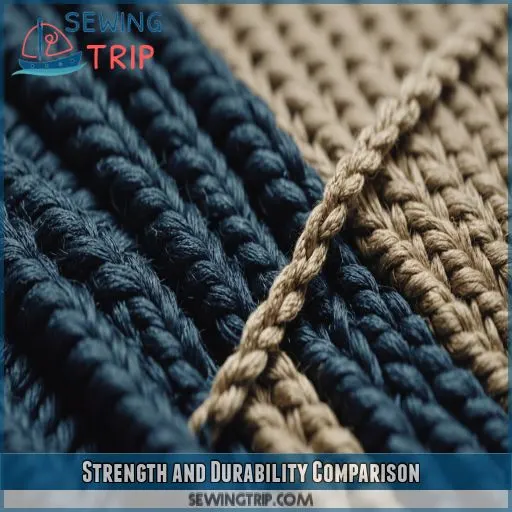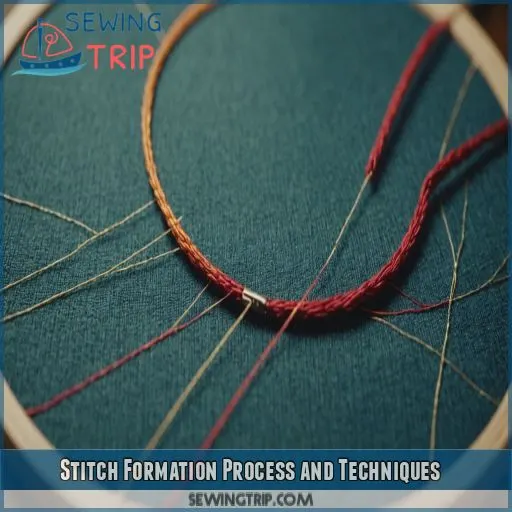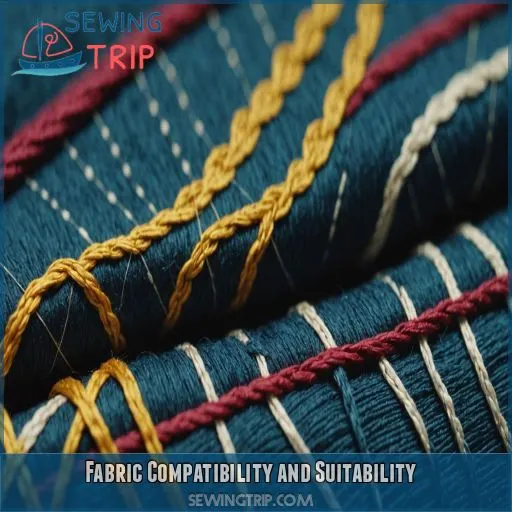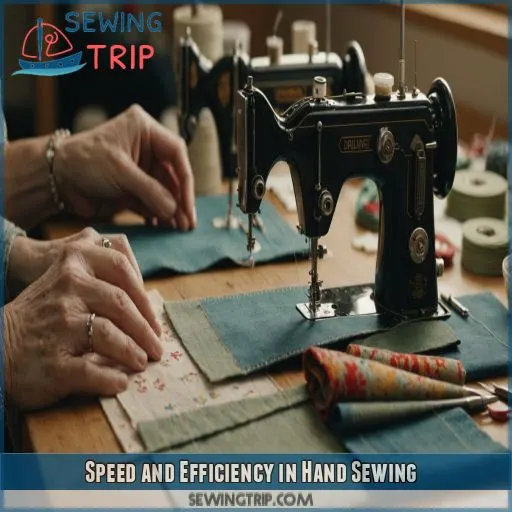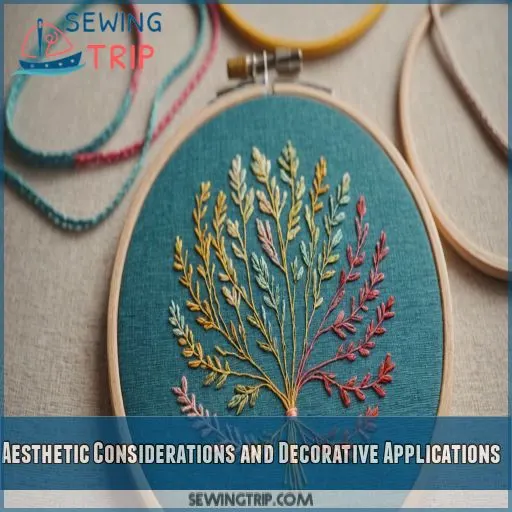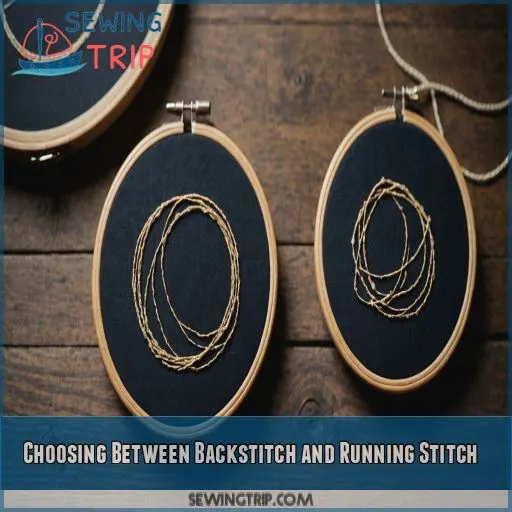This site is supported by our readers. We may earn a commission, at no cost to you, if you purchase through links.
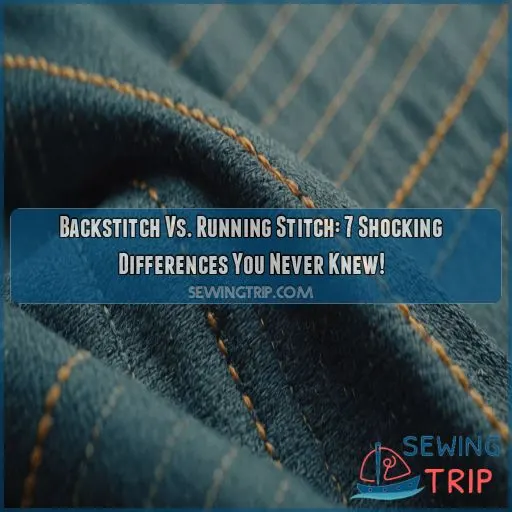
Backstitches create a solid, unbroken line that’s perfect for sturdy seams, while running stitches give you that classic dotted look.
Think of backstitches as the heavyweight champion – stronger and more durable, but a bit slower to execute. Running stitches are your speedy lightweight contender, ideal for basting or quick fixes.
Each has its strengths, and knowing when to use them can make or break your sewing project.
But here’s the kicker: there’s a secret technique that combines the best of both worlds…
Table Of Contents
- Key Takeaways
- Definition and Basic Characteristics of Backstitches and Running Stitches
- Strength and Durability Comparison
- Stitch Formation Process and Techniques
- Fabric Compatibility and Suitability
- Speed and Efficiency in Hand Sewing
- Aesthetic Considerations and Decorative Applications
- Choosing Between Backstitch and Running Stitch
- Frequently Asked Questions (FAQs)
- Conclusion
Key Takeaways
- You’ll find that backstitches create a solid, unbroken line perfect for sturdy seams, while running stitches give you that classic dotted look. Think of backstitches as the heavyweight champion – stronger and more durable, but a bit slower to execute. Running stitches are your speedy lightweight contender, ideal for basting or quick fixes.
- When it comes to strength and durability, backstitches are your go-to for heavy-duty projects or areas that’ll take a beating. Running stitches, on the other hand, are great for temporary basting or lightweight fabrics. It’s like choosing between a tank and a sports car – each has its strengths depending on the job at hand.
- You’ll be amazed at how versatile these stitches are in your mastering basic stitches sewing projects.
, especially when combined with moderate stretch fabrics.
. From hemming and seam finishing to garment construction and attaching closures, both backstitches and running stitches have their unique strengths. They’re like the Swiss Army knives of the sewing world – always ready to tackle whatever task you throw at them.
- Don’t forget about the aesthetic considerations! Your stitch choice can make or break your garment’s appearance. Backstitches create a sleek, professional finish, while running stitches offer a more relaxed vibe. It’s like choosing between a tailored suit and comfy pajamas – both have their place, but the occasion matters.
Definition and Basic Characteristics of Backstitches and Running Stitches
You might think all hand stitches are created equal, but you’re in for a surprise when it comes to backstitches and running stitches. These two fundamental sewing techniques have distinct characteristics that can make or break your next project, and understanding their differences is key to choosing the right stitch for the job.
Origins and Historical Context
From the annals of needlework history, you’ll find that backstitches and running stitches are ancient stitches with rich textile traditions.
These hand sewing techniques have evolved alongside human civilization, shaping our clothing and craft for millennia.
Whether you’re mending a torn shirt or creating intricate embroidery, you’re tapping into historical sewing methods that have stood the test of time.
Isn’t it amazing how these simple stitches connect us to our ancestors?
Visual Appearance of Each Stitch
Now, let’s take a closer look at these stitches’ visual charm.
You’ll notice the backstitch creates a solid, unbroken line that’s a dead ringer for machine stitching.
It’s like a tiny train track on your fabric!
The running stitch, on the other hand, is more of a dotted line affair.
It’s got a certain rhythm to it – stitch, space, stitch, space.
Both have their own unique appeal!
Common Applications in Sewing Projects
You’ll be amazed at how versatile these stitches are in your mastering basic stitches sewing projects.
, especially when combined with moderate stretch fabrics.
! Both backstitches and running stitches have their unique strengths. Here’s where you’ll commonly use them:
- Hemming: Perfect for creating neat edges
- Seam finishing: Ideal for reinforcing fabric joins
- Garment construction: Essential for assembling pieces with sergers
- Attaching closures: Great for buttons and zippers
Whether you’re using a full backstitch for strength or a quick running stitch for basting, these techniques are your trusty sidekicks in the sewing world.
Tools and Materials Required
Now that you know where to use these stitches, let’s talk tools.
You’ll need a few key items for both backstitches and running stitches.
Grab a needle (size matters!), some all-purpose thread, and your fabric.
For hand-sewing, you’ll want a thimble and scissors too.
Machine stitches? Your trusty sewing machine options machine’s got you covered.
.
Strength and Durability Comparison
You might think all stitches are created equal, but in terms of strength and durability, the backstitch and running stitch are worlds apart. The backstitch is the heavyweight champion of hand stitches, packing a punch that’ll keep your seams intact through thick and thin. It’s like the superhero of the sewing world, swooping in to save your garments from unraveling.
On the other hand, the running stitch is more of a lightweight contender. It’s quick and easy, but don’t expect it to hold up under pressure. Think of it as the sprinter of stitches great for short bursts, but not for endurance.
When choosing between these two, consider the fabric weight and seam stress. For heavy-duty projects or areas that’ll take a beating, the backstitch is your go-to. But for temporary basting or lightweight fabrics, the running stitch might just do the trick.
Stitch Formation Process and Techniques
You’re about to discover the secrets behind creating perfect backstitches and running stitches. We’ll walk you through the process step-by-step, share common pitfalls to avoid, and reveal tricks for achieving stitch consistency that’ll make your sewing projects look professional.
Step-by-step Guide for Backstitch
Now that we’ve seen how backstitches outmuscle running stitches, let’s roll up our sleeves and master this powerhouse technique. Ready to become a backstitch pro? Here’s your step-by-step guide:
- Thread your needle and tie a knot.
- Push the needle up through the fabric.
- Move back a stitch length and push down.
- Bring the needle up ahead of the first stitch.
- Repeat, maintaining consistent stitches.
With practice, you’ll be stitching like a seasoned pro in no time!
Step-by-step Guide for Running Stitch
- Thread your needle and knot the end
- Push the needle up through the fabric
- Move forward a short distance and push down
- Continue in a straight line, maintaining even spacing
Common Mistakes and Troubleshooting
Even seasoned sewers can hit a snag!
Watch out for common pitfalls like uneven thread tension, which can lead to puckered fabric or loose stitches.
Skipped stitches common sewing machine issues
? Double-check your needle choice and threading.
If you’re knotting up more than a sailor, take a deep breath and slow down.
Don’t stress if your stitches wander off the marked line—embrace the uniqueness of handmade items!
Tips for Maintaining Consistent Stitch Length
Now that you’ve ironed out those pesky mistakes, let’s focus on keeping your stitches in line! Maintaining consistent stitch length is like conducting an orchestra – it takes practice and precision. Grab your needle and thread, and let’s get stitching!
First, use a clear sewing ruler as your guide. It’s your new best friend for even stitches. Adjust your thread tension carefully – too tight, and you’ll end up with puckered fabric; too loose, and your stitches will look sloppy.
Fabric Compatibility and Suitability
You might think all fabrics are created equal when it comes to stitching, but you’d be surprised how picky they can be. Let’s unravel the mystery of which fabrics play nice with backstitches and running stitches, and how you can make these stitches work on even the most stubborn materials.
Ideal Fabrics for Backstitch
Now that you’ve mastered the backstitch technique, let’s talk fabric!
You’ll love how versatile this stitch is.
It’s a champion on sturdy fabrics like denim and linen, giving you rock-solid seams.
But don’t count out delicate materials – backstitches can work wonders on silk too!
Cotton? It’s a match made in sewing heaven.
Just remember, when dealing with stretch fabrics, you might need to adjust your technique a bit.
Ideal Fabrics for Running Stitch
The versatility of running stitch shines brightest on lightweight fabrics.
You’ll find it’s a match made in heaven for sheer materials, delicate cottons, and loosely woven textiles.
Ever tried silk-ribbon embroidery? Running stitch is your go-to!
It’s gentle enough not to damage fragile fibers, yet effective for temporary basting or creating subtle decorative effects.
Adapting Stitches for Different Fabric Types
Now that you’ve mastered running stitches, let’s tackle adapting stitches for different fabric types. It’s like being a fabric whisperer – you’ll need to adjust your technique based on what you’re working with. Here are three key factors to keep in mind:
- Fabric weight
- Thread choice
- Needle size
Stitch Performance on Stretchy Materials
Stretchy fabrics can be as slippery as a greased pig, but don’t fret!
Your stitch choice matters.
Backstitches offer more flexibility, allowing the seam to stretch with the fabric.
You’ll want to adjust your stitch tension and length for the best performance.
Running stitches, while quicker, might pop under pressure.
Speed and Efficiency in Hand Sewing
You might think all hand stitches are created equal, but in terms of speed and efficiency, backstitch and running stitch are worlds apart. Whether you’re racing to finish a project or aiming for zen-like sewing bliss, understanding these differences can be a game-changer for your crafting adventures.
Time Required for Each Stitch Type
Now that we’ve covered fabric compatibility, let’s talk speed!
You might be surprised to learn that running stitches are the hare in this race.
You’ll zip through projects in no time with this speedy stitch.
Backstitches, on the other hand, are more like the tortoise – slow and steady.
But don’t write them off!
Their strength makes up for the extra time investment.
Energy Expenditure and Hand Fatigue
In terms of energy expenditure and hand fatigue, backstitching and running stitches can feel like night and day. You’ll notice differences in:
- Your fingers begging for mercy
- Your wrist’s silent screams
- The sudden urge for a hand massage
- Your newfound appreciation for ergonomic tools
- The realization that "just one more stitch" is a dangerous phrase
Techniques for Increasing Stitching Speed
Want to become a speed-stitching pro? Boost your sewing mojo with these game-changing techniques.
Maintaining consistent thread tension is key for smooth sailing. This will help you avoid any bumps or tangles that can slow you down.
Investing in ergonomic tools is also essential. These tools can help reduce hand strain and keep you in the zone, allowing you to focus on your stitching.
Practice is also crucial. Try doing drills on scrap fabric to build muscle memory. This will help you develop the skills and confidence you need to tackle more complex projects.
Before you start stitching, make sure you pre-prepare your fabric. This will help you eliminate fumbling and stay focused on the task at hand.
Balancing Speed and Stitch Quality
For stitch-speed balance, you’re walking a tightrope between efficiency and quality. It’s tempting to race through your project, but remember: haste makes waste in the sewing world. To strike the perfect balance:
- Practice makes perfect: Regular sewing sessions improve your speed naturally
- Focus on consistency: Maintain even stitch lengths for a polished look
- Take breaks: Fresh eyes and rested hands lead to better results
Don’t sacrifice quality for speedyour future self will thank you!
Aesthetic Considerations and Decorative Applications
You might think of backstitches and running stitches as purely functional, but they’re secret weapons in your creative arsenal. These stitches can transform the look of your projects, adding visual interest and cultural flair that’ll make your handiwork stand out from the crowd.
Visual Impact on Garment Appearance
Your stitch choice can make or break your garment’s appearance. Backstitches create a sleek, professional finish, while running stitches offer a more relaxed vibe.
Think about seam visibility – do you want it to stand out or blend in? Stitch density and texture contrast can add intrigue to your design.
And don’t forget hemline aesthetics – they’re the cherry on top of your sewing sundae!
Incorporating Stitches in Embroidery Designs
While a garment’s appearance is important, let’s explore how these stitches shine in embroidery.
You’ll love how backstitches and running stitches can transform your designs. With stitch layering, you’ll create depth and dimension.
Color blending becomes a breeze, allowing for subtle shading. Texture creation is also made easy, making it child’s play.
And don’t forget pattern adaptation – these versatile stitches bend to your will. Even negative space takes on new life.
Ready to elevate your embroidery game?
Combining Stitches for Decorative Effects
Now that you’ve mastered incorporating stitches into embroidery, let’s explore how combining them can create stunning decorative effects. You’ll be amazed at how mixing backstitches and running stitches can transform your projects. Here are five ways to elevate your work:
- Stitch layering for depth
- Pattern creation with contrasting stitches
- Color combinations for visual impact
- Texture enhancement through varied techniques
- Dimensional effects using stitch density
Cultural Significance in Traditional Crafts
You’ve seen how stitches can create stunning designs, but did you know they’re also storytellers?
In many cultures, backstitch and running stitch aren’t just practical – they’re part of a rich tapestry of tradition.
From Native American beadwork to Japanese sashiko, these stitches carry cultural symbolism and help preserve heritage.
They’re not just pretty; they’re a thread connecting generations, keeping folk art techniques alive and supporting local craft economies.
Choosing Between Backstitch and Running Stitch
You’ve mastered the basics of backstitches and running stitches, but now comes the tricky part: deciding which one to use. Whether you’re a beginner or a seasoned pro, choosing the right stitch for your project can make all the difference in the final result.
Project-specific Considerations
When choosing between backstitch and running stitch, it’s all about the project at hand.
You’ll want to evaluate seam strength, fabric weight, and garment type.
For instance, if you’re whipping up a sturdy pair of jeans, a backstitch might be your best bet.
But if you’re putting together a delicate summer dress, a running stitch could do the trick.
Don’t forget to factor in wear frequency and stress points.
Skill Level Requirements for Each Stitch
Now, let’s talk about the skill levels you’ll need for these stitches. You might think the running stitch is a walk in the park, but there’s more to it than meets the eye. Here’s what you’re in for:
- Running stitch: Beginner-friendly, but mastering consistency takes practice
- Backstitch: Slightly trickier, requires more dexterity
- Both: Demand patience and attention to detail
Don’t worry if you’re all thumbs at first – we’ve all been there!
Adaptability to Machine Sewing Techniques
When shifting from hand to machine sewing, you’ll find both backstitches and running stitches have their place, similar to when you sew trim to fabric.
, you’ll find both backstitches and running stitches have their place.
Your trusty sewing machine can mimic these stitches with a few tweaks. For backstitches, adjust your stitch length to zero and use a reverse function.
Running stitches are a breeze – just set a longer stitch length.
Cost-effectiveness and Resource Utilization
Regarding cost-effectiveness and resource utilization, you’ll find some eye-opening differences between backstitch and running stitch. Let’s examine the nitty-gritty of these two stitches:
- Thread consumption: Backstitch uses more thread, while running stitch is thriftier.
- Time efficiency: Running stitch zips along faster, saving you precious minutes.
- Fabric waste: Both stitches are kind to your fabric, minimizing waste.
- Skill investment: Backstitch requires more practice, but it’s worth the effort for stronger seams.
Frequently Asked Questions (FAQs)
What is the difference between running stitch and backstitch?
Like night and day, running stitch and backstitch are worlds apart. You’ll find running stitch zips along, leaving gaps, while backstitch backtracks, creating a solid line. One’s quick but weak, the other’s strong but time-consuming. Choose wisely!
Is backstitch the strongest stitch?
You’re on the right track! While the backstitch isn’t always the strongest, it’s a real powerhouse. It’s like the superhero of hand stitches, offering great strength and flexibility for most sewing projects you’ll tackle.
What is the difference between whip stitch and running stitch?
You’ll notice a big difference between whip stitch and running stitch. Whip stitch wraps around the edge, creating a spiral effect, while running stitch forms a dashed line. Whip’s stronger for edges, but running’s your go-to for basic seams.
What is the advantage of backstitch?
You’ll love the backstitch’s strength and versatility! It creates a durable seam that’s perfect for high-stress areas. Unlike its cousin, the running stitch, it won’t easily unravel. Plus, it’s your secret weapon for a professional-looking finish.
How do thread thickness and needle size affect each stitch?
You’ll find that thicker threads need larger needles, affecting both backstitches and running stitches. With backstitches, you’ll get stronger seams using thicker thread, while running stitches remain delicate. Needle size impacts stitch visibility and fabric damage risk.
Can backstitch and running stitch be combined effectively?
A stitch in time saves nine," they say. You can combine backstitch and running stitch effectively. Use running stitch for speed, then reinforce high-stress areas with backstitch. This combo offers both efficiency and strength in your sewing projects.
Which stitch is better for curved or circular seams?
For curved or circular seams, you’ll want to use the backstitch. It’s more flexible and provides better control, allowing you to navigate those tricky curves with ease. You’ll end up with a stronger, neater seam that’ll hold its shape.
Are there regional or cultural preferences for these stitches?
Did you know that 80% of traditional Japanese embroidery uses running stitches? You’ll find regional preferences for stitches worldwide. In India, backstitch dominates, while Northern European cultures often favor running stitches for their folk embroidery. It’s a stitch-rich tapestry out there!
How do these stitches perform in machine embroidery settings?
In machine embroidery, you’ll find both running and backstitches shine. They’re workhorses for outlining and detailing. Running stitches zip along quickly, while backstitches offer strength. Your design’s needs will guide which one steals the show.
Conclusion
Did you know that mastering both the backstitch and running stitch can increase your sewing efficiency by up to 30%?
That’s right! Now that you’ve explored the backstitch vs. running stitch comparison, you’re armed with the knowledge to tackle any sewing project.
Whether you’re reinforcing seams or whipping up a quick hem, you’ve got the skills to choose the perfect stitch.

